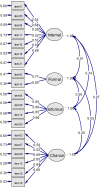Multiple dimensions of health locus of control in a representative population sample: ordinal factor analysis and cross-validation of an existing three and a new four factor model
- PMID: 21838862
- PMCID: PMC3175204
- DOI: 10.1186/1471-2288-11-114
Multiple dimensions of health locus of control in a representative population sample: ordinal factor analysis and cross-validation of an existing three and a new four factor model
Abstract
Background: Based on the general approach of locus of control, health locus of control (HLOC) concerns control-beliefs due to illness, sickness and health. HLOC research results provide an improved understanding of health related behaviour and patients' compliance in medical care. HLOC research distinguishes between beliefs due to Internality, Externality powerful Others (POs) and Externality Chance. However, evidences for differentiating the POs dimension were found. Previous factor analyses used selected and predominantly clinical samples, while non-clinical studies are rare. The present study is the first analysis of the HLOC structure based on a large representative general population sample providing important information for non-clinical research and public health care.
Methods: The standardised German questionnaire which assesses HLOC was used in a representative adult general population sample for a region in Northern Germany (N = 4,075). Data analyses used ordinal factor analyses in LISREL and Mplus. Alternative theory-driven models with one to four latent variables were compared using confirmatory factor analysis. Fit indices, chi-square difference tests, residuals and factor loadings were considered for model comparison. Exploratory factor analysis was used for further model development. Results were cross-validated splitting the total sample randomly and using the cross-validation index.
Results: A model with four latent variables (Internality, Formal Help, Informal Help and Chance) best represented the HLOC construct (three-dimensional model: normed chi-square = 9.55; RMSEA = 0.066; CFI = 0.931; SRMR = 0.075; four-dimensional model: normed chi-square = 8.65; RMSEA = 0.062; CFI = 0.940; SRMR = 0.071; chi-square difference test: p < 0.001). After excluding one item, the superiority of the four- over the three-dimensional HLOC construct became very obvious (three-dimensional model: normed chi-square = 7.74; RMSEA = 0.059; CFI = 0.950; SRMR = 0.079; four-dimensional model: normed chi-square = 5.75; RMSEA = 0.049; CFI = 0.965; SRMR = 0.065; chi-square difference test: p < 0.001). Results were confirmed by cross-validation. Results based on our large community sample indicated that western general populations separate health-related control-beliefs concerning formal and informal assistance.
Conclusions: Future non-clinical HLOC studies in western cultures should consider four dimensions of HLOC: Internality, Formal Help, Informal Help and Chance. However, the standardised German instrument needs modification. Therefore, confirmation of our results may be useful. Future research should compare HLOC structure between clinical and non-clinical samples as well as cross-culturally.
Figures

Similar articles
-
[French validation of the Verona Service Satisfaction Scale-VSSS-54F].Encephale. 2003 Mar-Apr;29(2):110-8. Encephale. 2003. PMID: 14567162 French.
-
Health Locus of Control Is Associated With Physical Activity and Other Health Behaviors in Cardiac Patients.J Cardiopulm Rehabil Prev. 2018 Nov;38(6):394-399. doi: 10.1097/HCR.0000000000000350. J Cardiopulm Rehabil Prev. 2018. PMID: 30106790
-
Validation of the "SmoCess-GP" instrument - a short patient questionnaire for assessing the smoking cessation activities of general practitioners: a cross-sectional study.BMC Fam Pract. 2010 Feb 1;11:9. doi: 10.1186/1471-2296-11-9. BMC Fam Pract. 2010. PMID: 20122143 Free PMC article.
-
Health Locus of Control and Medical Behavioral Interventions: Systematic Review and Recommendations.Interact J Med Res. 2024 Oct 10;13:e52287. doi: 10.2196/52287. Interact J Med Res. 2024. PMID: 39388686 Free PMC article. Review.
-
Does Epilepsy Have an Impact on Locus of Control?Front Psychol. 2020 Sep 9;11:2251. doi: 10.3389/fpsyg.2020.02251. eCollection 2020. Front Psychol. 2020. PMID: 33013587 Free PMC article. Review.
Cited by
-
Association Between the Health Locus of Control and Medication Adherence: An Observational, Cross-Sectional Study in Primary Care.Front Med (Lausanne). 2021 Aug 16;8:705202. doi: 10.3389/fmed.2021.705202. eCollection 2021. Front Med (Lausanne). 2021. PMID: 34490298 Free PMC article.
-
Safety education and control: A tool to measure the safety locus of control.J Educ Health Promot. 2012;1:21. doi: 10.4103/2277-9531.99951. Epub 2012 Aug 22. J Educ Health Promot. 2012. PMID: 23555124 Free PMC article.
-
Personality Variables as Predictors of Health Services Consumption.Int J Environ Res Public Health. 2021 May 13;18(10):5161. doi: 10.3390/ijerph18105161. Int J Environ Res Public Health. 2021. PMID: 34068016 Free PMC article.
-
The Spanish Body Image State Scale: Factor Structure, Reliability and Validity in a Colombian Population.Front Psychol. 2019 Nov 22;10:2553. doi: 10.3389/fpsyg.2019.02553. eCollection 2019. Front Psychol. 2019. PMID: 31824372 Free PMC article.
-
Measuring Intimate Partner Violence and Traumatic Affect: Development of VITA, an Italian Scale.Front Psychol. 2018 Jul 26;9:1282. doi: 10.3389/fpsyg.2018.01282. eCollection 2018. Front Psychol. 2018. PMID: 30093875 Free PMC article.
References
-
- Rotter JB. Social learning theory and clinical psychology. New York: Prentice Hall; 1954.
-
- Rotter JB. The development and application of social learning theory. Selected papers. New York: Praeger; 1982.
-
- Beck AT. Depression: Clinical, experimental and theoretical aspects. New York: Harper & Row; 1967.
-
- Beck AT. Cognitive models of depression. Journal of Cognitive Psychotherapy. 1987;1:5–37.
-
- Seligman MEP. Helplessness. San Francisco: Freeman; 1975.
Publication types
MeSH terms
LinkOut - more resources
Full Text Sources
Miscellaneous

